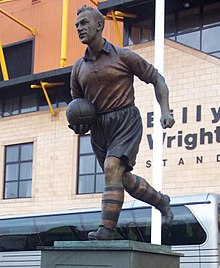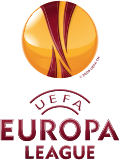Molineux Stadium
| Molineux Stadium | |
|---|---|

|
|
| The interior view of the Molineux Stadium (2005) | |
| Data | |
| place | Waterloo Road Wolverhampton WV1 4QR, United Kingdom |
| Coordinates | 52 ° 35 '24.4 " N , 2 ° 7' 49.4" W |
| owner | Wolverhampton Wanderers |
| operator | Wolverhampton Wanderers |
| opening | September 2, 1889 |
| First game | 7 September 1889 Wolverhampton Wanderers - Notts County 2-0 |
| Renovations | 1923, 1925, 1932, 1953, 1957, 1979, 1991–1993, 2011–2012 |
| surface | Natural grass |
| architect |
Archibald Leitch (conversion 1925) Atherden, Rutter (conversion 1979) Alfred McAlpine (complete renovation 1991–1993) |
| capacity | 32,050 seats |
| playing area | 106 × 68 m |
| Societies) | |
| Events | |
|
|
The Molineux Stadium [ mɒlɪnjuː ] is a football stadium in the English city of Wolverhampton in the West Midlands . It has been the home of Wolverhampton Wanderers football club since 1889 . It is only a few hundred meters north of the city center. The stadium, which is now completely equipped with seats, has a capacity of 31,700 after numerous renovations.
Located in a mostly low-rise area, the stadium has four grandstands: the Steve Bull Stand (previously named after former Chairman John Ireland), the Jack Harris Stand, the Stan Cullis Stand, and the Billy Wright Stand . In front of the latter stands a statue in honor of Billy Wright - 105 times England international and leading player of the most successful period of the Wolverhampton Wanderers in the 1950s - a statue.
history
Origins
The stadium name "Molineux" goes back to Benjamin Molineux, a Wolverhampton-based merchant who bought a plot of land in 1744 and built a house on it - the property known as "Molineux House" later became the famous " Molineux Hotel ". The Molineux family itself was one of the emigrants who moved to England at the beginning of the 14th century in the wake of Princess Isabella of France - wife of Edward II (Wolverhampton was regarded as the center of the relevant trade in Great Britain after the arrival of Flemish wool workers ). The elegant residence developed into a social gathering point and in 1792 was a refuge for French refugee families . In 1860, O. E. McGregor bought the property and, with the help of A. J. Brewster, turned the surrounding grounds into a public park, which hosted numerous public events, especially in the summer months. The "Molineux Grounds" were the central meeting point within the city and, in addition to an ice skating rink, a cycling track and a lake for boat trips, offered an area suitable for sports such as football. Croquet players first regularly used the site as a permanent sports facility in 1869.
The Northampton Brewery bought the site in 1889 and rented it to Wolverhampton Wanderers football club , who were looking for a new venue and had already played in a regional cup competition on the Molineux Grounds on March 20, 1886. Within a few months, eager planners and gardeners turned the green area into a sports venue suitable for regular gaming. The official inauguration of the "Molineux" took place on September 2, 1889 on the occasion of a friendly game against Aston Villa and a few days later the first championship game followed on September 7, 1889, which ended with a 2-0 win over Notts County in front of 4,000 spectators . Due to continuous improvement work between 1889 and 1910, the stadium was considered the best stadium in English football in terms of its comfortable equipment at the beginning of the 20th century.
In 1923 the stadium became the property of the Wolves for 5,607 pounds. Since no more work had been done on the Molineux since the First World War , the contemporary standard fell significantly behind the venues of other clubs. In particular, the serious deficiency remained that when there were large numbers of spectators, the view of the field was completely blocked for a not small proportion. With the help of the famous architect Archibald Leitch , the construction of a main stand on Waterloo Road began a short time later, with completion and final clearance in 1925. After that, the association replaced the north side, described as the “cowshed”, with a new covered stand. In 1932 a new grandstand was added on Molineux Street and two years later the Wolves also covered the South Stand. In this form with now four grandstands, the Molineux Stadium remained unchanged for almost 50 years, while the south side alone accommodated up to 30,000 spectators in the meantime.
The club was the first football club to install an extensive floodlight system for around £ 10,000 and officially inaugurated it on September 30, 1953 in a game against a selection from South Africa. It was the beginning of a series of famous "floodlit games" in the 1950s, when world-famous teams played friendly games in Wolverhampton. The games were considered very prestigious before the introduction of the European Cup , drew large audiences and the BBC broadcast them on television. In preparation for the first European Cup games, the club upgraded the facility again in 1957 for 25,000 pounds.
Remodeling and demolition

The grandstand on Molineux Street, which now consists entirely of seats, failed in accordance with the 1975 standards of the "Safety of Sports Grounds Act". Immediately behind it, under the guidance of architects Atherden and Rutter, the club built a new grandstand for 9,500 spectators, tore down the old grandstand in front of it after completion and opened the new John Ireland grandstand at the beginning of the 1979/80 season on 25 August 1979 against Liverpool new. The new grandstand was now very far away from the game because the lawn could not be moved. In addition, the entire construction project swallowed ten million pounds and drove the club deep into the red, which almost caused bankruptcy in 1982 until the rescue by a consortium led by Derek Dougan .
After the Valley Parade fire disaster in Bradford, the league association tightened the security measures again and the Wolves, who had crashed into the fourth division in 1986 , had to close the dilapidated grandstands to the north and on Waterloo Road, leaving only the south stand and the John Ireland grandstand were used. In step with the decline in sporting performance, the number of viewers also fell massively at this time. The tense financial situation in the club did not allow repair work or lawn transplants, and so the stadium faced further decline. Wolverhampton City Administration saved the football club from final ruin in August 1986 by buying the stadium and the surrounding area from the club for £ 1.12 million, but although the stadium could continue to be used, the closed stands remained unused .
New construction of a pure seating stadium
After Jack Hayward took over the club and the stadium in 1990, the way was paved for a fundamental renovation, which was inevitable in order to meet the requirements of the Taylor Report and not to endanger the game by the 1993/94 season at the latest. First, the entire north stand fell victim to the demolition in October 1991 and the new Stan Cullis stand at the same location was completed on time for the 1992/93 season. This was followed by the grandstand on Waterloo Road, which was replaced a few months later by the Billy Wright grandstand. The final phase began in November 1993 when the south Jack Harris grandstand reopened.
For the first game in the now completely renovated stadium, Honvéd Budapest - an opponent from the famous time of the floodlit games - played in Wolverhampton on December 7, 1993 . The stadium, which now consists entirely of seats, had a capacity of 28,525 and at that time was one of the largest stadiums among the converted venues.
In honor of the Wolverhampton Wanderers' record goalscorer, the club renamed the John Ireland grandstand to the Steve Bull grandstand in 2003. In addition, there was a temporary grandstand in the southwest corner, which, as the Graham Hughes grandstand, offered space for a further 900 spectators. It was mainly intended to take account of the increased popularity expected from promotion to the Premier League and made it possible for the record number of 29,396 spectators to be reached in the renovated stadium on January 17, 2004. This “additional grandstand” was removed as early as 2006, although a renewed start-up was not ruled out in the event of a renewed promotion to the premier league, nor were further solutions for the other three “corners”, which could increase the capacity to around 32,500. In addition, there are plans to expand the Steve Bull and Billy Wright grandstands to a total capacity for around 40,000 visitors. In August 2015, the Jack Harris booth was renamed the Sir Jack Hayward booth to honor Steve Morgan's predecessor as owner of the club, who had previously passed away that same year.
The record attendance for the stadium and in its current configuration was against Liverpool on December 21, 2018 and is 31,358.
Special events
The first international match played at Molineux Stadium ended on March 7, 1891 with a 6-1 victory for England against Ireland . Against the same opponent, the English team completed another game at the same place on February 14, 1903 (4-0); afterwards England lost 1: 2 to the Welsh selection on February 5, 1936 . A 5-2 win over Denmark in a qualifier for the 1958 World Cup in Sweden was the last appearance of an English senior team in Wolverhampton. Nevertheless, the stadium is still the home ground for international matches for England's youth teams, including two games of the English U-21 team in 1996 and 2008 .
In addition to other FA Cup semi-finals, Molineux was also the venue for rugby union games and a boxing tournament when, for example, Henry Cooper fought Jack Bodell in 1967 for the British heavyweight championship. On June 24, 2003, Molineux Stadium hosted approximately 34,000 spectators at a live concert by Bon Jovi , making it the most crowded live event in Wolverhampton.
Visitor record and average attendance
The record number of audience is 61,305 and came during a game of the fifth round of the FA Cup in the season 1938/39 against FC Liverpool (4: 1) on 11 February 1939 - long before the restrictive requirements of the Taylor Report - concluded . The record as a purely seated stadium was set on February 18, 2017. The match in the 5th round of the 2016/17 FA Cup between Wanderers and Chelsea (0: 2) saw 30,193 spectators.
- 2012/13: 21,773 ( Football League Championship )
- 2013/14: 20,879 ( Football League One )
- 2014/15: 22,419 (Football League Championship)
- 2015/16: 20,157 (Football League Championship)
- 2016/17: 21,570 (Football League Championship)
literature
- Matthews, Tony: Wolverhampton Wanderers - The Complete Record . Breedon Books, 2008, ISBN 978-1-85983-632-3 , pp. 60-65 .
Web links
- molineuxstadium.co.uk: Official website of the Molineux Stadium (English)
- thewolvessite.co.uk: The History of Molineux 1889-1989 ( Memento from December 19, 2013 in the Internet Archive ) (English)
- footballgroundguide.com: Stadium Guide (English)
- stadionwelt.de: picture gallery
- stadiumguide.com: Molineux Stadium (English)
- stadiumdb.com: Molineux Stadium (English)
Individual evidence
- ↑ Premier League Handbook 2018/19 . Premier League. July 30, 2018.
- ↑ a b footballgroundguide.com: Record attendance and average attendance (English)
- ↑ 'Fans deserved at least one goal', says Nuno . Wolverhampton Wanderers FC December 21st 2018.

